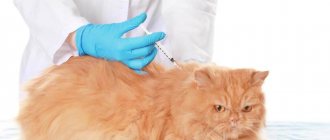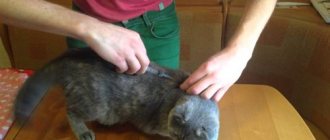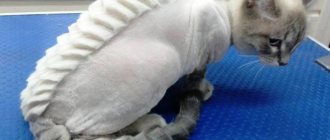Sometimes you need to give your cat an injection yourself without the help of a veterinarian. This happens, for example, when living in a country house or in a village, when it is not possible to travel to a veterinary clinic every day, but treatment is necessary.
Giving an injection to a cat is not at all difficult, you just need to know the difference between an intramuscular injection and a subcutaneous injection and understand the tactics of administration.
Choosing a syringe for injection
Instruments for pets are purchased at a regular pharmacy for people. There are three types of injections: intramuscular, subcutaneous, intravenous. Each option requires different syringes and needles.
For intramuscular
In this case, the injection is carried out into the muscle of the cat's back or front leg. Syringe volumes are allowed: 1, 2, 5, 10 ml. If you need to administer a dose of more than 1 ml, you need to choose three-component syringes. In addition to the needle and piston, the design includes a plunger that allows the needle to move gently. The black seal is located at the end of the piston where the needle is inserted.
After choosing the correct volume, you should decide on the needle. For a cat and especially a kitten, it is better to choose thin needles. When choosing a syringe with a capacity of 2.5 ml or more, take a 30x0.6 mm needle or from an “insulin syringe”.
“Insulin syringes” work well with doses less than 1 ml. They got their name from the frequent administration of insulin to diabetic patients. The tool has two positive characteristics. First, it has a plunger for gentle movement. Secondly, the needle is short. Beginners should not worry about the depth of the needle.
Important! The needle must be very sharp. If she was getting medicine through the rubber stopper, the needle should be replaced.
For subcutaneous
In this case, the injection is made into the withers of the animal. Since the skin here is soft, not so stretched, it has few nerve endings. The cat feels less and, therefore, tolerates even painful injections well.
The volume of the syringe can be different, but the needle should be chosen 30x0.6 ml. This is the case if the medicine is not oil-based.
Often subcutaneous injections are accompanied by medications with an oily structure. To prevent the drug from clogging the passages in the needle, you need to choose needles of a larger diameter, since the oily and viscous structure of the drug hardens quickly. For example, if the syringe has a volume of 3 ml, then the needle should be selected 40x0.7 mm, etc.
Intravenous injection is carried out only by specialists.
Why does an owner need to learn how to give an injection to a cat?
In veterinary clinics, specialists carry out various manipulations, including injections, but any owner cannot do it himself, and there are several reasons for this:
- Sometimes, if an animal’s temperature rises sharply, it is necessary to first lower it, and only then take the cat to the clinic.
- Not all veterinary clinics are open 24 hours a day, and your pet needs immediate help. For example, in small towns.
- Visiting a clinic and having a painful procedure performed by a stranger is a highly stressful situation for a cat.
- When a course of injections is prescribed, it is not very convenient to visit the veterinarian every day.
- Calling a specialist to your home is quite an expensive pleasure and not everyone can afford it, and if it is necessary at night or in the evening, the price doubles.
The owner does not always have to give injections himself, but in case of emergency it would be good to learn this simple manipulation.
1111
Basic rules and recommendations
When self-administering the drug, be sure to follow the rules of personal hygiene:
- before the procedure, wash your hands with soapy water and wipe with alcohol;
- use a disposable syringe, always sterile;
- do not touch the needle with your hand;
- a new sterile needle is required for each injection;
- do not use open ampoules.
Sometimes expensive drugs are intended for several injections. Don't start with a different bottle each time. It is enough to draw the recommended doses into various syringes and close them with plastic caps. Medicines should be kept in the refrigerator; shelf life should be indicated in the instructions for the medicine.
Although it is not always possible to use this method. For example, powdered medications are diluted immediately before the procedure , as they tend to create a sediment. Before use, the ampoules are warmed in your hands. The temperature of the medicine should be slightly higher than the ambient temperature.
Important! You cannot use a clean ampoule whose name has been erased. Check the expiration date of the drug, throw out expired copies.
In open boxes, check the name of the medicine. Since, quite possibly, during cleaning they put a single ampoule in an empty space in the box.
Read the instructions before use; you may need to shake the drug before use.
Prepare a special file for opening the ampoule. Wrap it with cotton wool and press in the opposite direction. Some copies have a mark. Then, insert the needle. For convenience, lift the ampoule upside down and draw the solution. After filling the container, squeeze out the excess air from the syringe with a piston.
Do not try to combine two medications into one device. A negative reaction and sedimentation may occur.
Decide on the type of injection. Not all drugs can be administered intramuscularly or subcutaneously. For example, calcium chloride is administered only intravenously, and diphenhydramine is suitable only for two types of injections: intravenously, intramuscularly. Any discrepancies can lead to tissue death and worsen the situation.
Lameness
Limping on the hind leg is common after injection. Most often, this happens after painful injections - antibiotics or thick, oily medications.
Veterinarians assure that there is no need to worry about lameness - most often, pets begin to run on the 2nd day.
But if your Murzik has been limping for 3-4 days, then you need to take action, since this is not a normal phenomenon. In this case, you need to show the cat to the doctor as soon as possible, and he will determine the cause of the lameness and prescribe the appropriate course of treatment.
Administration technique
The speed of drug administration plays a role with intramuscular injection. The more medicine, the slower it must be administered. For example, a volume of 1 ml should be stretched over 2-3 seconds, and 0.5 ml should be injected in one second.
Injections separate the muscles and thereby cause microtrauma to the body. Therefore, a certain calculation is used to administer the required amount of medicine for cats of different weights. For an average cat weighing 4 kg, one place should contain 1 ml of the drug. If you need to inject a larger amount, then you need to inject in several places.
With a subcutaneous injection, the speed of drug administration is not significant. The amount of liquid per 1 kg is limited to 70 ml.
Intramuscular injection
In order for the medicine to work quickly, an intramuscular injection is usually given. The best place for injection is considered to be the middle of the thigh.
Algorithm of actions
Preparation:
- The procedure will be quick and successful if you carry out the preparatory work. We put cotton wool, a syringe, medicine, a file, and alcohol on the table in advance.
- Read the instructions carefully. Let's say you notice a discrepancy with your veterinarian's prescription. Call your doctor and find out before you get the injection.
- Wash your hands with soap and wipe with alcohol.
- Before filing the ampoule, make sure the medicine is at the bottom. If the medicine gets into the narrow part of the bottle, tap the sides with your finger and distribute it correctly.
- Point the needle into the cut neck and turn the ampoule over. This will make it more convenient to collect liquid.
- Once the solution is drawn into the syringe, turn the syringe upside down with the needle so that the air droplets rise up. Press the plunger until the needle is filled with medicine and the air is expelled.
- Don't worry before the procedure, otherwise your cat will sense it and become agitated and tense. You need to calm the cat with caressing movements to relax the muscles.
- There is no need to lubricate the injection site with anything, as this can only damage the antibacterial layer of the skin.
Injection:
- If you have a partner, let him put the cat on its side and hold it by the paws. For independent actions, you can use a bag with a fixative for injections. Also use a large clothespin. Fasten it behind the withers. The cat will think that someone is holding it and will sit quietly. The owner has the opportunity to work with both hands.
- Use your fingers to feel the bone in advance so as not to hit it with a needle.
- There is no need to pinch the injection site in the muscle.
- Some medications should not enter the blood vessels. Therefore, during the injection, pull back the plunger and make sure that no blood enters the syringe and calmly inject the solution. If there is blood, remove the needle and make a new puncture.
- Insert the needle into the middle of the thigh 10 mm at an angle of 45 degrees.
- The rate of administration depends on the amount of solution. Each ml of medicine must be administered for at least 2-3 seconds, each subsequent ml is administered more slowly.
- After injecting the liquid, pull out the needle at the same angle that was inserted before. There is no need to wipe the injection site.
Video instructions on how to give an intramuscular injection to a cat:
Subcutaneous injection
Injections under the skin are recommended by the instructions, if there is a large amount of medication and it causes pain. This is the method used to administer Nobivak injections, which are well known to cat owners.
Algorithm of actions:
- Carry out preparatory work: get medicine, alcohol, file, cotton wool.
- Clean your hands with alcohol.
- Read the instructions.
- Take medicine.
- Position the cat comfortably, open the withers for procedures. Pull it up and make a fold with your fingers.
- Place the needle parallel to the back and insert it into the fold. If you use an “insulin syringe”, then deepen the needle completely, with a syringe of another type - 0.5 cm. If after a puncture the needle falls in, this is a signal that the needle has successfully punctured. We administer the medicine.
- After the injection, pull out the syringe along the same projection.
Preparation for the procedure
I recommend starting any stress interventions with caring attention to the animal. Most often, cats are afraid of injections and can behave aggressively, which means you must take care of your pet’s comfort. Some animals, when they see their owner with a syringe, hide. I describe how to catch a cat in another article.
Choosing a place
Choose a flat and non-slip surface for manipulation. There are different cats: some are brave and are not afraid of treatment, and some lose their courage. Therefore, make sure in advance that you have a thick towel on hand (in case of pet aggression) and a disposable diaper if the cat cannot restrain the urge to go to the toilet out of fear.
Preparing medicines
Do not prescribe the medicine yourself, administer it only as directed by your doctor. Before the procedure, double-check the dosage and order of administration of drugs (if there are several of them), because the cat’s resistance can cause confusion and confusion.
It is important to check with your doctor at what speed the drug should be administered. This is very important because it allows you to avoid shock and rapid intoxication.
Some medications must be kept in the refrigerator. Before the procedure, they should be taken out and left for one and a half to two hours to warm up to the cat’s body temperature (37-38 degrees) or to room temperature.
Prepare additional cotton wool and hydrogen peroxide to stop the bleeding if something goes wrong. Provide convenient and quick access to them.
Where is the cat's withers?
Many pet owners want to know where the cat's withers are? In other words, it's the scruff of the neck. The place where the back connects to the neck. To put it even more simply, take it by the scruff of the neck and take it by the withers, the same thing.
When injecting in the place where the cat's withers is located, be patient. Under no circumstances should you shout at the animal or try to forcefully break its possible resistance. If your pet is acting anxious and lashing out, recruit another family member to help. You can wrap your cat in a sheet.
The longer you wait to insert the needle, the more nervous your pet will become. You don't want him to experience stress, do you? Therefore, do everything quickly and confidently, following the above instructions. Remember all these steps, or better yet, save them in your bookmarks.
Remember that the method of administration of the drug and dosage must be determined by a veterinarian. In the next article, we recommend that you read about cat vaccination.











